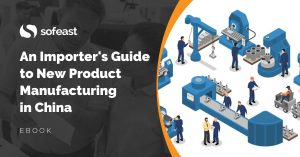By Fabien Gaussorgues
Do you need to manufacture a plastic part in China? The first question is usually ‘what is the best material?’ comes before prototyping and before deciding on a manufacturer.
The most common plastics used in China are acrylic (PMMA), acetal (POM), nylon (PA66), polycarbonate (PC), acrylonitrile (ABS), thermoplastic (PET), polypropylene (PP), low density polyethylene (LDPE), and polyetheretherketone (PEEK).
There is usually no straightforward answer. Many criteria have to be considered, and a compromise often needs to be chosen.
The most common criteria clients mention are listed below:
- Resistance to wear
- Strength
- Transparency
- Food or flame grade
- Hardness
- Price
- Tolerances
- Melting temperature
To make this choice more complicated, it is possible to mix some materials — for example ABS/PC, or adding some fiber glass for a better fit to the final product.
There are also significant differences between Chinese “no name” raw material and branded offers coming from China, Taiwan (e.g. Formosa, Chimei), Germany (e.g. BASF, Bayer) and the USA (e.g. Dupont, Sabic).
When the performance is critical and is close to the limit of what the material can achieve, it is important to control its source and to identify the material origin. For example, for high precision, you might want a plastic with low shrinkage, and adding fiber will improve performance.
There are two more reasons for controlling the source:
- You need to ensure the plastic is the same from one batch to the other.
- The tolerance for changes is low when a mold is involved. Most of the time, changing the material will mean changing the mold and scrapping the old one! Material selection and expected performances should be part of the product specification before deciding on a manufacturer.
There are many resources available online to help the user find the right raw material. However, it is also important to rely on the manufacturer’s experience (assuming you have found a manufacturing partner you can trust). They can suggest solutions you might not have thought of.
What else? Sometimes, you might simply want to reuse the same plastic as an existing product with similar performance requirements. How to ‘reverse engineering’ it and discover what plastic they used? The solution is to burn it!!!
Most plastics have different behaviors, and product families can be identified this way.
Side note:
This method can also confirm if your supplier used the right type of plastic. The temptation to save on purchasing costs is very high, especially if they think you will not pay for expensive laboratory tests.
We listed a few other simple tests that can be carried out to check a plastic’s flexibility here.
Here are some useful online resources regarding the choice of the right polymer for injection molding:
- Shortlist of main plastics, and some selection criteria
- Database of material properties — a huge database to find what plastic will be a good fit for your project
Are you designing, or developing a new product that will be manufactured in China?
Sofeast has created An Importer’s Guide to New Product Manufacturing in China for entrepreneurs, hardware startups, and SMEs which gives you advance warning about the 3 most common pitfalls that can catch you out, and the best practices that the ‘large companies’ follow that YOU can adopt for a successful project.
It includes:
- The 3 deadly mistakes that will hurt your ability to manufacture a new product in China effectively
- Assessing if you’re China-ready
- How to define an informed strategy and a realistic plan
- How to structure your supply chain on a solid foundation
- How to set the right expectations from the start
- How to get the design and engineering right
Just hit the button below to get your copy (please note, this will direct you to my company Sofeast.com):


Great post.
So, how do I go about to specify this to a supplier? Can I say Formosa PMMA?
Anywhere I can find spec sheets from these manufacturers?
Sure, as a buyer you can direct a supplier for a critical component/material. Very common. Ideally you have enough volume that you get in touch with the material supplier themselves (e.g. Formosa), negotiate a price, and get updates about deliveries to your suppliers. This is a way you control that they don’t procure that material from somewhere else.
If your volumes are small, maybe you can ask your direct supplier to source from Formosa and show you the invoices. Or you find a wholesaler that distributes Formosa’s products (that’s probably how your direct supplier will do, anyway…)
I had no idea that there were so many different types of plastic manufactured in China! I also appreciate that you included common criteria mentioned by clients when choosing a plastic manufacturer. Is it cheapest to manufacture plastic in China right now?
Yes, for many applications China is the cheapest place for doing plastic injection molding. But not for all applications, of course.